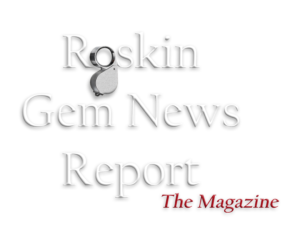De Beers is stepping into more visible territory–both in jewelry design and in how it tells the story of its natural diamonds.
At the center of its new strategy are two launches: Ombré Desert Diamonds, a jewelry design concept built around “soft color blends” using brown natural diamonds alongside cape yellow natural diamonds; and Origin, De Beers Group, a branded polished diamond offering tied to digital traceability (Tracr).
(Please read both this feature story as well as the Rapaport Breakfast feature with Al Cook, CEO of the De Beers Group.)
By Gary Roskin
Roskin Gem News Report
Diamond Jewelry Design
As you know, the Roskin Gem News Report doesn”‘t usually spotlight jewelry design–unless it involves something truly interesting with gem materials.We have recently highlighted a few of De Beers’ High Jewelry Collections that have appeared on the runway, using yellow and brown rough diamond crystals. De Beers has a new collection, and this time, internationally available in a lower price point.
Ombré Desert Diamonds is part of what De Beers calls a new “beacon” initiative–meant to be picked up by retailer jewelers around the globe. But what”‘s most notable is the company”‘s direct role in shaping the look of the jewelry itself.
While De Beers has influenced design trends before, e.g. the eternity ring and the three-stone ring, this level of involvement marks a more hands-on approach, really leaning in to help retail jewelers sell more natural diamonds – natural diamonds of a larger color palette to include TLBs (top light browns), browns, and what they are calling Amber (cape stones and brownish-yellows/yellowish-browns). And there are several reasons for this.
Color and Inventory
The Ombré concept is specifically designed to spotlight a wider range of natural diamond colors–light yellows (cape), and browns–a blended category that retail jewelers have traditionally struggled to sell – which also means De Beers has a backlog of rough in these colors. AND maybe just as important, not so easily duplicated in synthetics.
All things considered, these diamond designs aim to help retailers move natural diamonds at more accessible price points, all within a design-forward, De Beers-backed program.
- Inspired by Nature: The collection draws inspiration from the colors found in desert landscapes, ranging from warm whites and champagne tones to amber hues.
- Emphasizing Natural Beauty: This line aims to highlight the inherent beauty and emotional resonance of natural diamonds.
- Industry “Beacon”: Ombré Desert Diamonds will serve as a “beacon,” a product backed by De Beers that will be available to the wider diamond industry, allowing different businesses to participate in a category marketing idea.
- Color Variations: The collection will feature various color options to reflect the diverse hues found in the desert environment.

“To support the success of Ombré Desert Diamonds, De Beers Group is investing significantly in media and digital campaigns to drive consumer demand at the point of sale. De Beers Group will also be making marketing collateral available to beacon participants.”
Origin – The Story
At the same time, De Beers is rolling out Origin, a polished diamond program that gives retailers a new tool for talking about provenance. Backed by the Tracr blockchain platform (owned by De Beers), Origin diamonds come with digital profiles that include country of origin, rarity scoring, and information about the social programs the stone has supported. The idea is to make it easier for jewelers to answer a growing number of customer questions about where a diamond came from–as well as who and what it supports (which is a good thing. Read our feature on the Rapaport JCK Breakfast for more details.)
The idea is to make it easier for jewelers
to answer a growing number of customer questions
about where a diamond came from–as well as who and what it supports.
These moves are part of De Beers”‘ broader “Origins” strategy, announced in 2024 [reported here last year in our feature Spotlight on De Beers]. The company says it has met all its early goals, including exploration progress in Angola and the expansion of traceability features across its supply chain.
“Origin, De Beers Group will provide consumers with the opportunity to purchase diamonds sourced from De Beers Group with enhanced assurance, reinforcing their ethical provenance as part of the marketing mix.”
With these two initiatives, Ombré and Origins, De Beers is aiming to reposition natural diamonds (and De Beers)–pairing modern storytelling with practical, design-driven merchandising. How well this works at the retail counter remains to be seen, but the company is clearly changing its tone– as De Beers leans into both Origin, and into the colors of “Ombré Desert Diamonds.” – gr
Synthetics for Technology
De Beers also announced new developments at its Oregon-based Element Six facility. That site, focused on industrial diamond technology, has begun producing its first diamond wafers. At the same time, the company confirmed the closing of its Lightbox lab-grown jewelry division, while continuing its work on synthetic diamonds for industrial uses.
De Beers using rough diamond crystals in High Jewelry Designs













